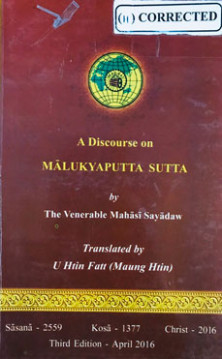Malukyaputta Sutta
Author By - Mahasi Sayadaw Gyi
test
Malukyaputta Sutta
Published Date - 2016
Buddha Date - 2560
Myanmar Date - 1378
AD Date - 2016
Author By - Mahasi Sayadaw Gyi
119 စာမျက်နှာ
FOREWORD TO THIRD EDITION
Malukyaputta Sutta was a very concise discourse given by Lord Buddha to an old bhikkhu known as Malukyaputta, on the subjects of vipassana meditation. When Sir. U Thwin, the first president of the Buddha Sasana Nuggaha Organization, was searching a suitable meditation teacher for the Yangon Sasana Yeiktha, he requested his friend U Ba Thin, a rich rice mill owner, to invite Mahasi Sayadaw from Seikkhun Village in Shwebo Township to deliver a sermon.
Sayadaw came on 2nd August 1947 and delivered Malukyaputta Sutta at Thameikdawdaya retreat at Sagaing Hills. In fact, it could be said that this sutta brought Mahasi Sayadaw to Yangon Sasana Yeiktha because Sir U Thwin found the preaching of this sutta went in harmony with the composure, respectable appearance and bahaviour of the Sayadaw. After listening to the Sayadaw preachings for five days on the practical aspect of Vipassana meditation, Sir U Thwin and the Buddha Sasana Nuggaha Organization decided to invite Sayadaw to Yangon to act as the meditation teacher at the newly formed Sasana Yeiktha. As mentioned in the Short Biography of the Sayadaw, at the invitation of the then Prime Minister of Myanmar U Nu, and Sir U Thwin, Sayadaw came down to Yangon in 1949 and first batch of meditators were given training in meditation practice on 4th December 1945. Since the Sutta spelled out the method of insight meditation in detail, the Mahasi Sayadaw had preached this sutta many times including one at Thaddhamma Thitagu Yeiktha in Pathein during 1981.
This discourse was tape-recorded only in 1968 when the Mahasi
Sayadaw started delivering on 17th August 1976 at Mahasi Sasana
Yeiktha. When the tape recordings were transcribed and probably edited by Mahasi
Sayadaw, it was put into book form and published in July 1978, by Seikkhun Mahasi
Yeiktha with the approval of the Sayadawgyi. It is one of the three books
the publishing rights of which were given to Seikkhun Mahasi Yeiktha by Mahasi
Sayadaw.
This book has been reprinted many times with the original introduction of Ven. Sandarwara of Thayet. Aungmingala, a touring DhammaKahtika and meditation teacher of Mahasi Sasana Yeiktha, written on 21st December 1977. The last printing was in 2008.
For the foreign yogies, this book was translated into English by Saya U Htin Fatt (Maung Htin), a famous writer as well as a translator of a number of discourses of Mahasi Sayadaw, and published in September 1981 followed by a second edition published in December 1994. This second edition being out of stock, we have the pleasure of publishing a third edition incorporating the correction of some of the printing errors in the previous editions.
Bhikkhu Pesala of Association for Insight Meditation had also published a new English edition in August 2013, completely revising our original editions. In our third edition, we exactly follow the previous two editions, as translated by U Htin Fatt.
Mahasi Sayadaw in delivering this Malukyaputta Sutta explained Six Vipassana Questions and Answers followed by 24 stanzas expressed by Malukyaputta and elaborated by Lord Buddha himself stanza by stanza. We are confident that meditating yogies will greatly benefit by following these teachings and practicing diligently, and thereby attain insight knowledge leading to extinguishing defilements and realizing Nibbana.
Dr.Tint Soe Lin
President
Buddha Sasana Nuggaha Organization
April, 2016
A Discourse On Malukyaputta Sutta
This copy is Third Edition published in Apirl 2016 in which the grammar, punctuations and spellings of English words were corrected during December 2018 for the next Edition.
(1) English words corrected by “ Microsoft Words” in computer by Ma Soe Soe
on 7.12.2018 and checked by U Khin Maung Oo on 7.11.2018 and 15-12 -2018.
(2) Pali words re-checked by ----------------------.
Note; the words in red are not to be uploaded in the website.

